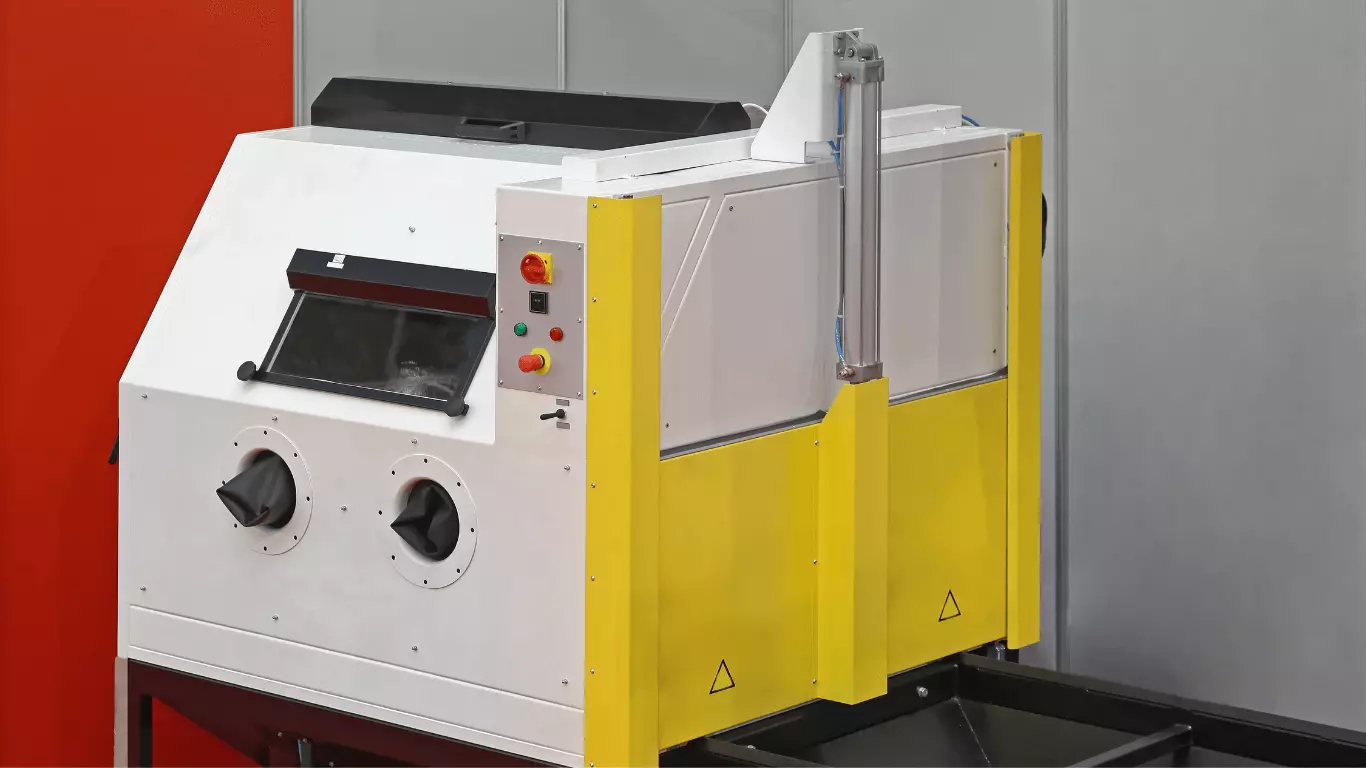A blasting cabinet, also known as a sandblasting cabinet, is a powerful tool that can revolutionize your workspace efficiency. Whether you’re a DIY enthusiast, a professional painter, or an industrial worker, a blasting cabinet offers numerous benefits. In this article, we will delve into the world of blasting cabinets, exploring their functionalities and advantages. Discover how this versatile equipment can streamline your workflow and help you achieve impeccable results.
What is a Blasting Cabinet?
A blasting cabinet is a sealed chamber used in industrial and automotive settings for blasting materials with abrasive media. It efficiently cleans polishes, or strips surfaces by directing a high-pressure stream of particles onto the target object. Equipped with gloves and adjustable nozzles and regulators, it offers precision and versatility for various applications. A blasting cabinet is essential for removing paint and rust and preparing surfaces for painting or coating.
What’s the Deal with Blasting Cabinets?
Blast cabinets are necessary equipment in the field of surface finishing. They resemble a unique box form that can be used to clean, strip, or finish various surfaces with an abrasive material stream under high pressure. However, how do they function, and why are they so crucial? Let’s take a brief look at this.
Why Use a Blasting Cabinet?
Let’s say you wish to repaint a rusty, old bike. You could spend hours removing the rust or taking a few minutes using sandpaper and a blasting cabinet. Fast and effective, blast cabinets can get into each nook and cranny without causing damage to the object you’re working on.
How Does a Blasting Cabinet Work?
A blasting cabinet is pretty straightforward:
- The Cabinet: This is the box where the action happens. It’s sealed to keep the abrasive material inside.
- The Abrasive: This is the ‘sand’ in sandblasting, though it can be made of various materials, such as glass beads or steel grit.
- The Gun: This tool blasts the abrasive at high speed onto the object you’re cleaning.
- The Dust Collector: After the blasting, there is a lot of dust. This part cleans the air to keep your workspace tidy.
Who Uses Blasting Cabinets?
People of all stripes use blast cabinets, from enthusiasts working in their garages to experts in the automotive, aerospace, and manufacturing industries. They work well for etching designs into metal or glass, wiping off old paint or corrosion, and priming surfaces for painting or coating.
What Can You Do with a Blasting Cabinet?
The possibilities are almost endless. You can:
- Clean: Remove dirt, grease, or rust from metal parts.
- Prepare: Get surfaces ready for painting or coating.
- Finish: Create a specific texture or smoothness on a surface.
- Etch: Carve designs into glass or stone.
Are Blasting Cabinets Safe?
Yes, if it’s used right. The cabinets come with gloves built right into them, so you can work with the things without touching the rough stuff. You can also look through the window to see what you’re doing without opening the drawer.
What Should You Consider When Choosing a Blasting Cabinet?
Think about:
- Size: Make sure it’s big enough for the items you want to blast.
- Power: More power means faster cleaning and more wear on the cabinet.
- Abrasive: Different materials work better for different jobs.
Can You Make Your Blasting Cabinet?
It’s possible, but it takes a lot of work. You must ensure it’s sealed well and has a good dust catcher. Most people find buying a cabinet that is already made more accessible and safer.
What Are the Challenges of Using a Blasting Cabinet?
The biggest obstacle is ensuring you’re using the appropriate abrasive for the task. If it’s abrasive, the object can get damaged. If it’s too fine, it might not be clean as well. Maintenance and part replacement are also essential to keep the cabinet functioning correctly.
Is a Blasting Cabinet Worth the Investment?
Yes, for many individuals. Investing in a blasting cabinet can save time and effort if you frequently work with cleaning and finishing products. Once you have this tool, you’ll question how you got along without it.
Advantages of Using a Blasting Cabinet
- Provides excellent control and precision: Adjust pressure, media type, and nozzle size for the desired blasting effect.
- Encompasses the surrounding area: Constructs the blasting process within an enclosed space, minimizing cleanup and dust spread.
- Ensures operator safety: Protects eyes, lungs, and skin from potential harm from abrasive media and dust.
- Ensures efficiency and time-saving: Allows for quick and effective completion of blasting tasks.
- It offers a comprehensive solution for any blasting project, combining precision, containment, operator safety, and time efficiency.
Key Considerations Before Purchasing a Blasting Cabinet
When choosing a blasting cabinet, consider size, construction, materials, and compatibility with specific media types. Choose cabinets made from sturdy materials like steel for durability.
Ensure the cabinet is easy to use with convenient front or side doors for loading and unloading parts. Consider features like adjustable air pressure and abrasive flow controls for flexibility. Consider safety measures like ventilation s, gloves, and eye protection. Happy blasting!
Applications of Blasting Cabinets
One of the most common applications of blasting cabinets is in the automotive industry. Imagine you have a rusty old car part that needs to be restored. You can place it inside the blasting cabinet and direct the abrasive media towards it, as all the rust and grime get blasted away. It’s like giving the part a fresh start, making it look brand new again.
Blasting cabinets are also widely used in the manufacturing sector. They are handy for preparing surfaces before painting or coating. Workers can remove contaminants or rough patches from the material using the blasting cabinet, ensuring a smooth and clean surface for further processing.
Blasting cabinets are fantastic for removing old paint, varnish, or finishes from wooden surfaces. Whether it’s a piece of furniture or a wooden art project, the blasting cabinet can strip away all the old layers, allowing you to start afresh with your creative endeavors.
Blasting cabinets have numerous practical applications across different industries. They save time, effort, and resources by providing an efficient and controlled surface cleaning and preparation environment. Blasting cabinets are a game-changer whether it’s automotive restoration, manufacturing processes, or woodworking projects.
How to choose the right blasting cabinet
When selecting a blasting cabinet, consider size, construction material, media compatibility, visibility, and safety features.
Choose a cabinet that fits your project and items, and consider the durability of steel, aluminum, or plastic materials. C
hoose a cabinet compatible with the media you will be blasting, such as sand, glass beads, or walnut shells. Ensure the cabinet has built-in lighting and large viewing windows for optimal visibility.
Consider safety measures like gloves, an air filter, and a dust collector to protect yourself from harmful particles.
Setting Up and Operating a Blasting Cabinet
So you’re interested in setting up and operating a blasting cabinet, huh? Well, let me walk you through the process. A blasting cabinet, also known as a sandblasting cabinet, is a specialized piece of equipment used for cleaning, etching, or finishing various surfaces by propelling abrasive materials at high speed.
You’ll need to find a suitable location for your blasting cabinet. Ensure it’s in a well-ventilated area, preferably with an exhaust to remove dust and fumes. Safety should always be a top priority, so don’t forget to wear protective gear such as goggles, gloves, and a respirator.
Once you’ve set up your blasting cabinet, it’s time to choose the correct abrasive material for your project. Depending on the surface you’re working on, options like sand, glass beads, or aluminum oxide can be used. Remember to follow the manufacturer’s recommended abrasive size and operating pressure guidelines.
Load the item you want to clean or finish into the cabinet, ensuring it’s securely positioned. Switch on the cabinet’s power and adjust the air pressure and abrasive flow to achieve the desired blasting intensity. Move the nozzle across the surface in a steady and controlled manner, maintaining a consistent distance.
Start with smaller projects to learn the blasting process before tackling larger ones. Remember to clean and maintain your blasting cabinet regularly to ensure optimal performance.
With the right setup, materials, and precautions, you’ll be able to operate a blasting cabinet effectively and achieve fantastic results for your projects.
Troubleshooting and Common Issues
A blasting cabinet is a handy tool for cleaning and preparing surfaces by blasting them with abrasive materials like sand or glass beads. One common issue you might face is the abrasive not flowing properly. If you notice that the abrasive material is not coming out consistently or there’s a weak flow, first check the air pressure. Make sure it is at the recommended level for your specific cabinet. If the pressure is fine, inspect the abrasive delivery for clogs or blockages. Clearing those out should do the trick!
The first thing to check is the visibility window. Make sure it’s clean and not obstructed by debris or residue. If that’s not the issue, then the problem might lie with the lighting. Check the bulbs and replace them if necessary. Sometimes, a simple fix like cleaning the lens can also make a world of difference.
If you notice air or abrasive material escaping from the cabinet, it’s important to locate and fix the source of the leak. Inspect the seals, gaskets, and hoses for any damage or wear. Replace any faulty components and ensure everything is properly tightened. This should help resolve the issue and keep your blasting cabinet working smoothly.
Troubleshooting involves identifying the problem step by step and finding the right solutions. If necessary, consult the manufacturer’s manual or seek professional assistance.
Conclusion
Robust equipment like blast cabinets helps make a difficult task much easier to handle. Regardless of your level of experience, they can assist you in completing your assignments flawlessly. Thus, it might be time to try a blasting cabinet if you’re sick of scraping away at rust or faded paint. Who knows? Your productivity might soar to unprecedented levels.
Unique FAQs
-
Can I use any abrasive media in a blasting cabinet?
- While most blasting cabinets are compatible with a wide range of abrasive media, it’s essential to consult the manufacturer’s guidelines to ensure compatibility and optimal performance.
-
How often should I replace the filter cartridges in my blasting cabinet’s dust collector?
- The frequency of filter cartridge replacement depends on various factors, such as the volume of blasting operations, the type of abrasive media used, and the level of contamination. It’s recommended that the filter cartridges be inspected regularly and replaced when they show signs of clogging or wear.
-
Are blasting cabinets suitable for removing heavy rust and corrosion?
- Blasting cabinets are highly effective for removing heavy rust, corrosion, and paint from metal surfaces. However, efficiency may vary depending on the type and size of abrasive media used, the blasting pressure, and the nozzle configuration.
-
Can blasting cabinets be used for delicate surfaces such as wood or plastic?
- While blasting cabinets are primarily designed for metal surfaces, they can be used for delicate materials such as wood or plastic with appropriate adjustments to the blasting pressure, media type, and nozzle distance. It’s essential to conduct tests on a small, inconspicuous area to determine the suitability and avoid damage to the substrate.
-
How can I minimize dust and debris in my blasting cabinet’s workspace?
- To minimize dust and debris in the workspace, ensure proper ventilation, use an efficient dust collection , and clean the cabinet regularly to remove accumulated media and contaminants. Additionally, consider using abrasive media with low dust generation and implementing containment measures such as curtains or shields around the blasting area.

